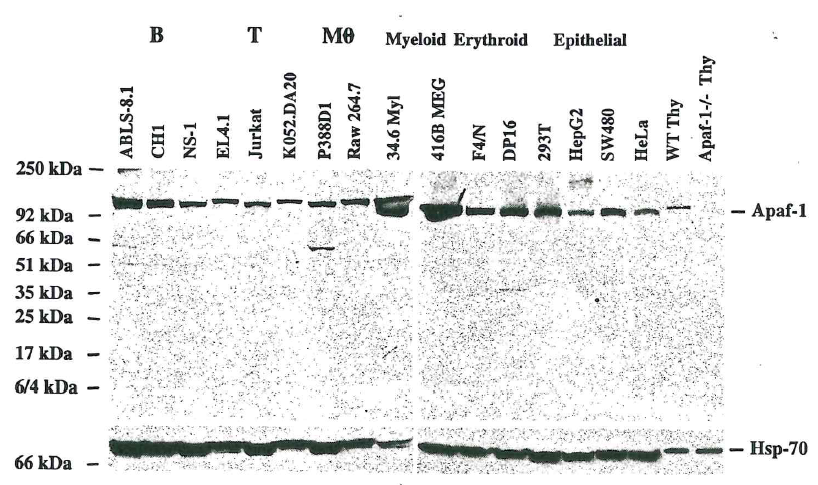anti-Apaf-1 mAb (18H2)
Product Code:
AG-20T-0134
AG-20T-0134
Antibody Clonality:
Monoclonal
Monoclonal
Regulatory Status:
RUO
RUO
Target Species:
- Human
- Mouse
Applications:
- Enzyme-Linked Immunosorbent Assay (ELISA)
- Immunocytochemistry (ICC)
- Immunoprecipitation (IP)
- Western Blot (WB)
Shipping:
Blue Ice
Blue Ice
Storage:
Short term: +4°C. Long term: -20°C
Short term: +4°C. Long term: -20°C
No additional charges, what you see is what you pay! *
| Code | Size | Price |
|---|
| AG-20T-0134-C100 | 100 ug | £271.00 |
Quantity:
Prices exclude any Taxes / VAT
Stay in control of your spending. These prices have no additional charges to UK mainland customers, not even shipping!
* Rare exceptions are clearly labelled (only 0.14% of items!).
* Rare exceptions are clearly labelled (only 0.14% of items!).
Multibuy discounts available! Contact us to find what you can save.
This product comes from: Switzerland.
Typical lead time: 7-10 working days.
Contact us for more accurate information.
Typical lead time: 7-10 working days.
Contact us for more accurate information.
- Further Information
- Documents
- References
- Show All
Further Information
Alternate Names/Synonyms:
Apoptosis Protease-activating Factor 1
Concentration:
1mg/ml
EClass:
32160000
Endotoxin:
<0.1EU/µg purified protein (LAL test; Lonza).
Form (Short):
liquid
Formulation:
Liquid. In PBS containing 0.02% sodium azide.
Handling Advice:
After opening, prepare aliquots and store at -20°C.Avoid freeze/thaw cycles.
Immunogen:
Recombinant mouse Apaf-1 (aa 1-97) containing the N-terminal CARD domain.
Long Description:
Monoclonal Antibody. Recognizes the CARD domain of human and mouse Apaf-1. Does not cross-react with rat Apaf-1. Isotype: Rat IgG2akappa. Clone: 18H2. Applications: ELISA, ICC, IP, WB. Liquid. In PBS containing 0.02% sodium azide. Apaf-1 is a cytoplasmic protein that forms one of the central hubs in the apoptosis regulatory network. It contains (from the N terminal) a caspase recruitment domain (CARD), an ATPase domain (NB-ARC), few short helical domains and then several copies of the WD40 repeat domain. Upon binding cytochrome c and dATP, this protein forms an oligomeric apoptosome, mediates the cytochrome c-dependent autocatalytic activation of pro-caspase-9 (Apaf-3), leading to the activation of caspase-3 and apoptosis.
NCBI, Uniprot Number:
O88879
Package Type:
Plastic Vial
Product Description:
Apaf-1 is a cytoplasmic protein that forms one of the central hubs in the apoptosis regulatory network. It contains (from the N terminal) a caspase recruitment domain (CARD), an ATPase domain (NB-ARC), few short helical domains and then several copies of the WD40 repeat domain. Upon binding cytochrome c and dATP, this protein forms an oligomeric apoptosome, mediates the cytochrome c-dependent autocatalytic activation of pro-caspase-9 (Apaf-3), leading to the activation of caspase-3 and apoptosis.
Purity:
>95% (SDS-PAGE)
Specificity:
Recognizes the CARD domain of human and mouse Apaf-1. Does not cross-react with rat Apaf-1.
Transportation:
Non-hazardous
UNSPSC Category:
Primary Antibodies
UNSPSC Number:
12352203
Use & Stability:
Stable for at least 1 year after receipt when stored at -20°C.
Documents
References
Apaf-1 is a transcriptional target for E2F and p53: M.C. Moroni, et al.; Nat. Cell Biol. 3, 552 (2001) | Apocytochrome c blocks caspase-9 activation and Bax-induced apoptosis: A.G. Martin & H.O. Fearnhead; J. Biol. Chem. 277, 50834 (2002) | Apaf-1 and caspase-9 accelerate apoptosis, but do not determine whether factor-deprived or drug-treated cells die: P.G. Ekert, et al.; J. Cell. Biol. 165, 835 (2004) | Is Apaf-1 expression frequently abrogated in melanoma?: J.D. Allen, et al.; Cell Death Differ. 12, 680 (2005) | The DNA repair complex Ku70/86 modulates Apaf1 expression upon DNA damage: D. De Zio, et al.; Cell Death Differ. 18, 516 (2011) | Apoptosome formation upon overexpression of native and truncated Apaf-1 in cell free and cell-based systems: A.R. Noori, et al.; Arch. Biochem. Biophys. 642, 46 (2018) | The Lumiptosome, an engineered luminescent form of the apoptosome can report cell death by using the same Apaf-1 dependent pathway: E.S. Hosseini, et al.; J. Cell Sci. 133, 242636 (2020) | Loss of WD2 subdomain of Apaf-1 forms an apoptosome structure which blocks activation of caspase-3 and caspase-9: A.R. Noori, et al.; Biochim. 180, 23 (2021)



